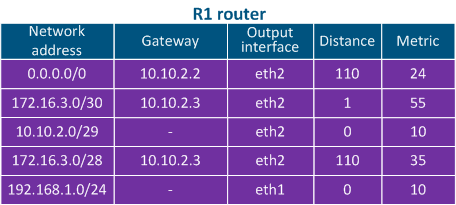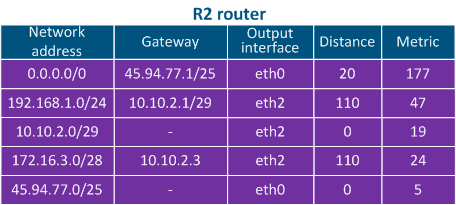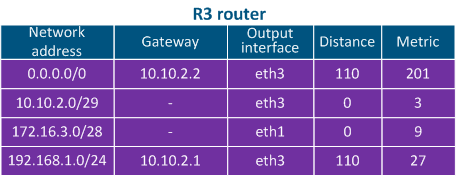...
- Network address: the packet's destination IP address specified in the service header is checked to see if it belongs to the network address indicated in the table. If the destination belongs to this network, than the current table entry can be used for data transmission. The best match is used, which is not always the exact match.
- Gateway address: the IP address of the next router (hop), to which the packet will be forwarded.
- Output interface: the network interface for outbound packet transmission.
- Distance: in the networks with having redundant communication channels, there are several paths to the same network. These routes can be obtained from one or several sources, however, only one of these routes should be placed in the routing table. To prioritize the routes from different sources, use the Administrative Distance parameter (or Distance) is used, which means reflects the level of trust to into this source. The route from the source with the lowest Distance value will be added to the routing table, as a lower Distance value means a higher level of trust. General The general recommendations for Distance values are followed by most manufacturers of network equipment (Table 3).
- Metric: a route multiple routes to the same network can be obtained not only from different sources, as mentioned above, but also from the same source. These routes are prioritized using the Metric value, when added to the routing table. Each routes route source calculates the metric using different algorithms, so the metrics from different sources cannot be directly compared.
| Center | |||||||||||||||||||||||||||||||
|---|---|---|---|---|---|---|---|---|---|---|---|---|---|---|---|---|---|---|---|---|---|---|---|---|---|---|---|---|---|---|---|
Table 3 - Distance values depending on the route source |
Routing table management
Each router along the packet transmission path has the a routing table management algorithm. The algorithm is the following:
- Step 1: the destination address is checked for belonging to networks, which entries are against the networks present in the routing table to see if it finds a match.
- Step 2: if few several records satisfy the requirement of step 1, the "narrowest route" is selected, i.e. the entry with having the maximum netmask value is selected. For example, mask /24 is narrower than /8.
- Step 3: if at the step 2 there are several routing table entries with the same network masks, the Distance parameter is compared. The lower the value of this parameter, the higher the priority of the route priority.
- Step 4: if at the step 3 there are several entries in the routing table with the same Distance valuesvalue, the metrics are compared. The lower the metric value, the higher the priority of the route priority.
- Step 5: if there is no entry in the routing table that meets the requirements of step 1 and there is no default route, the packet is dropped.
...


